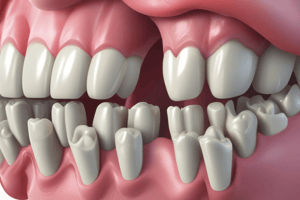Podcast
Questions and Answers
What does Type I represent in the AAP Classification?
What does Type I represent in the AAP Classification?
- Abscesses of the periodontium
- Plaque induced gingival diseases (correct)
- Chronic periodontitis
- Aggressive periodontitis
What is Type II in the AAP Classification?
What is Type II in the AAP Classification?
- Periodontitis as manifestation of systemic disease
- Necrotizing periodontal disease
- Aggressive periodontitis
- Chronic periodontitis (correct)
Which type refers to aggressive periodontitis?
Which type refers to aggressive periodontitis?
- Type II
- Type I
- Type III (correct)
- Type IV
What does Type IV indicate in the AAP Classification?
What does Type IV indicate in the AAP Classification?
Type V in the AAP Classification is associated with which condition?
Type V in the AAP Classification is associated with which condition?
Which type represents abscesses of the periodontium?
Which type represents abscesses of the periodontium?
What does Type VII denote?
What does Type VII denote?
What does Type VIII refer to in the AAP Classification?
What does Type VIII refer to in the AAP Classification?
What are plaque induced gingival diseases?
What are plaque induced gingival diseases?
Gingival diseases modified by systemic factors can include:
Gingival diseases modified by systemic factors can include:
Which options describe gingival diseases modified by medications?
Which options describe gingival diseases modified by medications?
Non-plaque induced gingival lesions may include which of the following?
Non-plaque induced gingival lesions may include which of the following?
What factors can lead to gingival diseases modified by malnutrition?
What factors can lead to gingival diseases modified by malnutrition?
What is a traumatic lesion?
What is a traumatic lesion?
What defines Type II localized chronic periodontitis?
What defines Type II localized chronic periodontitis?
What is the characteristic of Type II generalized chronic periodontitis?
What is the characteristic of Type II generalized chronic periodontitis?
Flashcards are hidden until you start studying
Study Notes
AAP Classification of Periodontal Diseases and Conditions
- Type I: Plaque-induced gingival diseases, primarily related to the buildup of dental plaque.
- Type II: Chronic periodontitis, characterized by inflammation and progressive attachment loss.
- Type III: Aggressive periodontitis, a severe form often seen in younger individuals with rapid attachment loss.
- Type IV: Periodontitis as a manifestation of systemic disease, indicating that systemic health issues impact periodontal health.
- Type V: Necrotizing periodontal disease, featuring ulceration and necrosis of the periodontal tissues.
- Type VI: Abscesses of the periodontium, involving localized infections within periodontal tissues.
- Type VII: Periodontitis associated with endodontic lesions, where periodontal health is affected by dental pulp inflammation.
- Type VIII: Developmental or acquired deformities and conditions impacting periodontal structures.
Plaque Induced Gingival Diseases
- Plaque-induced gingivitis can be influenced by systemic factors, medications, and malnutrition.
- Systemic factors include hormonal changes linked to puberty, menstruation, pregnancy, and conditions like diabetes.
- Medications can lead to drug-induced gingival enlargements or influence gingivitis, such as those associated with oral contraceptives.
- Malnutrition-related gingival diseases include scurvy, stemming from vitamin C deficiency.
Non-Plaque Induced Gingival Lesions
- These lesions arise from specific bacterial, viral, or fungal origins, as well as genetic factors or systemic conditions.
- Bacterial-origin diseases include lesions associated with Neisseria gonorrhea, Treponema pallidum, and Streptococcal species.
- Viral-origin lesions primarily result from herpes infections.
- Fungal-origin diseases involve Candida species and conditions like histoplasmosis.
Gingival Manifestations of Systemic Conditions
- Mucocutaneous disorders linked to systemic conditions include lichen planus, pemphigoids, erythema multiforme, and lupus erythematosus.
- Allergic reactions from dental materials (e.g., mercury, nickel) or products (toothpaste, mouthwash) can also cause gingival issues.
Trauma and Foreign Body Reactions
- Traumatic lesions may arise from chemical, physical, or thermal injuries.
- Foreign body reactions occur when the body responds to foreign materials located within the gums.
Chronic Periodontitis Classification
- Type II localized chronic periodontitis occurs when 30% or fewer sites exhibit attachment and bone loss.
- Type II generalized chronic periodontitis is indicated by attachment and bone loss at more than 30% of sites.
- Type II mild chronic periodontitis is characterized by a clinical attachment loss of 1 to 2 mm.
Studying That Suits You
Use AI to generate personalized quizzes and flashcards to suit your learning preferences.




